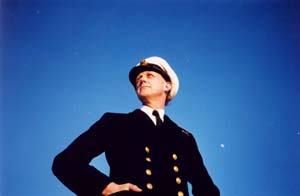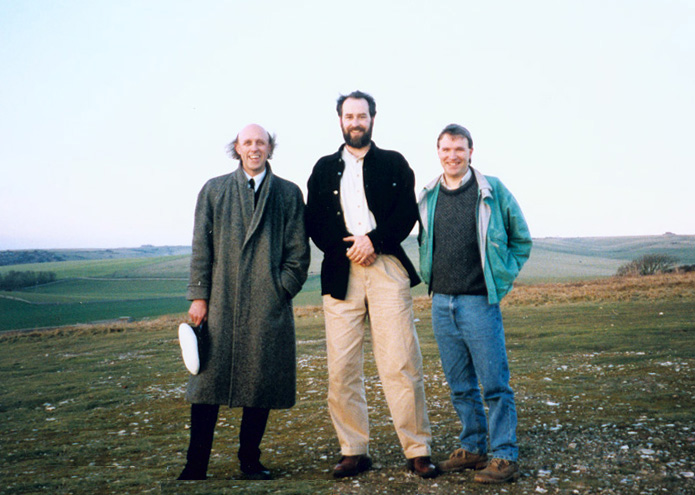






We were talking as we walked around the cliffs of Beachy Head. Judge was dressed in the uniform of an officer of the ill-fated R101, and trying to convey to me the size of this largest of airships. “It was bigger than the biggest ocean liner, and this thing flew, if you can imagine something as big as the Queen Mary coming slowly overhead - that is the key image - the surreal unbelievable fact of these things actually flying!”
His thinnish face is animated with an infectious enthusiasm as he speaks; “it was the peak of the technology of the time. It’s like the space shuttle: if you can imagine the space shuttle with a cocktail piano and veranda, and a promenade deck and dressing for dinner...” From under the peaked cap his eyes search the surrounding hills, as if for airships.
Judge Smith has a long history. Born in 1948 he was the original drummer, as well joint singer and songwriter, with the first incarnation of the rock band Van der Graaf Generator, appearing on their 1968 single shrieking out a song based on a Norse Saga. Since then he has (despite jumping ship the same year) continued to write both for, and with, that band’s leading figure Peter Hammill.
He has also produced a considerable body of work in a wide range of styles and approaches, from writing pop songs for Lene Lovich, through texts for a number of choral and dramatic pieces, to composing a number of (often rude) ditties for the ‘Not the Nine-o-Clock News’ TV programme. Along the way he also lays claim to having written the worlds first liturgically correct heavy metal Latin Requiem Mass !
It is however his collaboration with Hammill a couple of years ago on ‘The Fall of the House of Usher’, a through-sung opera in the rock tradition, which provides the closest reference point for the current work in progress. In ‘Curly’s Airships’ it is Judge’s desire to produce something with a real rock sound, but which has much more of a Classical structure. He will be using rock instruments but the new work will also feature sung narrative with extended melodies and recurring themes that emphasise (in some cases ironically) the action of the piece.
Although this means that he will in many ways be breaking new ground, he would refuse an ‘avant-garde’ tag; “I like to do stuff that can be understood. I like words that make sense and I like melodic content that you can latch onto.” With it’s whole cast of characters and story told through a variety of song and music there is a danger that it could be described as a ‘rock opera’, but it is clear, as Judge interweaves the various elements of his piece, that in ‘Curly’s Airships’ he is creating something much richer, much more cohesive and more demanding than the ‘rock operas’ from the ‘60s and ‘70s which in reality of course were usually no more than a series of 3-minute songs strung together to tell a story. It will, nevertheless as he says “be recognisable to people who like rock music”.
The ‘Curly’ of the title is Curly McLeod, a (fictional) officer of the (factual) British Airship Programme and the piece follows his career through the events of the period right through to his immolation in the R101 disaster - and on into the paranormal activity that was reported afterwards, when apparently the spirits of a number of officers made seance appearances, eager to point the finger of blame at those responsible.
It seems that a number of mistakes were made; “The programme, the Airship adventure, is so extraordinary, so bizarre and so horrific. It was a series of cock-ups, disasters and mistakes.” In particular it appears that (despite using flammable gas to fill the things) safety checks on the R101 were drastically curtailed in order to enable it to be ready in time for a prestigious event. Judge sums the whole thing up as “a wonderful story of official lunacy and brave men dying through official foolishness and corruption - very British.”
This element is clearly one of the things that draws him to the subject; “the British character interests me a lot. I’m very interested in Britishness and it seems to me that the period between the wars expressed that, with all it’s good points and it’s bad points in a very rich way. I like that period and I think I understand a bit about the people who were around then.” He also clearly delights in the language of the times; “the slang of that period is wonderful. There’s a lot of wonderful phrases and turns of speech that were only current round about then - 1st World War to the 2nd. There’s a lot of it in the piece”.
Judge clearly finds the subject to be fertile ground for composition. There are also a number of ways in which music enters directly into the telling of the story: "One of the British dirigibles after the 1st World War went on a tour of industrial towns trailing a large banner selling Government Victory Bonds, with a military band on top of the airship - they had machine gun nests and so on up there and they crammed a brass band on, roped them down, and they had to play while this thing was cruising up and down". Judge has written several pieces that will simulate this in the piece (sailing slowly from one speaker to the other) to be played by a real military band.
There are also 'Airship Songs'! "Hydrogen is poisonous and you can't smell it - but it has the same effect on your voice as helium, it makes it go falsetto. There were riggers on these things, whose job it was to check for leaks while they were flying, and they would have to crawl around the inside, over the gas bags, looking for leaks, and they would sing all the time. That was the only way of telling when they were getting a dangerous concentration of hydrogen - because their voices would go high". There will be at least one Rigger’s Shanty in the finished work, although whether with, or without falsetto’s is not clear!
Earlier at the compact 16 track studio in his cottage Judge Smith had premiered some of the new piece. Apologising for the fact that vocals have not yet been added to the work in progress he proceeded to sing two lengthy tracts of the piece live, over computer-sequenced demo's. His distinctive, slightly reedy, voice is expressive as he sings of the joys of flight and the grace of the dirigibles. One can easily empathise with his viewpoint that these large whale-like objects actually provided a more dignified and graceful way to fly.
The piece is now virtually completely written, using computer, keyboard and sound sampler. Judge's achievement in writing it is made all the more remarkable by the fact that he is, as he freely admits, no musician. He has built the piece up with a fairly painstaking technique but is clearly liberated by the ability of the computer to reassign whatever note is played on the keyboard to the one that is actually desired! He has now created, in effect, a large canvas that can be fleshed out in recording over the next year with a variety of prospective guest musicians and singers (including indeed one or two members of the Stranglers).
‘Curly’s Airships’ when complete will be about 2 hours long. Judge explains that “it’s a big story - you have to give it some room in order to flesh out the characters and to get people into the smell of the thing - you know the taste of what it’s like to fly on an airship”.
The resulting recording will not be Judge Smith's first work to be released, he currently has 2 CD's available. Both are collections of songs, with no particular thematic thread running through them. Released on a tiny label called 'Oedipus Recs' the first "Democrazy" picks up more than a decade of demo versions of songs - including several later performed by Peter Hammill. Judge’s most recent release for the same label "Dome of Discovery" features 12 songs performed by what Judge styles a “Virtual Reality band” of musicians conjured up by the magic of computer sampling.
And a very strange band it is too - 4 trumpets, 4 cello players, an electric guitar (Duane Eddy twangy style) and bass, combined with a large mixed operatic-type choir, a soprano, and a cajun style snare drummer. The resulting sound clearly has rock n roll as one of its parents, but also has, as Judge says, “a lot of Eastern European feel about it, with Hungarian, Gypsy elements to it”.
Unable for practical reasons to set up and rehearse such an ensemble Judge set about making his own computer samples, with which he could then begin to build the sound of his dream band.
He had already tried and rejected the available commercial samples. For example he found the available samples of Choirs weak. “They were very polite people going ‘woooooh’ in a gentle sort of way that would go nicely in the background..... but I didn’t want that, I wanted large ladies in white dresses bellowing at the tops of their lungs and chaps in dinner jackets with bald heads bellowing”.
The same was true for all the other instruments: the available samples just weren’t energetic enough. For example the cello’s; “I wanted Punk cello’s, where they play the thing with a lot of fist, a lot of energy, and you just can’t buy that”.
The result is very real sounding instruments playing in a slightly unreal band, and unlike any other computerised music album you ever heard. “It’s completely computerised, but I sweated blood and spent months and months trying not to make it sound like it”.
It will however share with it’s predecessors a particular quality of imagination which characterises all of Judge’s work; an ability to invest vitality and an almost crazy kind of energy into the most unlikely subject matter ! In a different world the energy and originality of his work would be enough to guarantee him a ready audience for ‘Curly’s Airships’. In the real world of course, things are pigeon-holed, and Rock and Pop in particular are dominated by a youth culture and a hit-single mentality that leave little room for someone like Judge. He is aware of the superficiality in the business, Pop music is meant to be disposable, timespans should be short and subject matter trivial. “The expectations for artistic achievement in Rock’n’Roll is very very low indeed”. If you don’t have the right image - if your work is too demanding or you are just plain too old then you can kiss radio airplay goodbye. It is always hard to be rejected, but it must be particularly ironic to be rejected because your work is not disposable enough!
Judge has plans to take ‘Curly’s Airships’ out himself as a one-man show. Maybe then audiences, confronted by a multi-media performance from the man in the 1920’s airship officer’s uniform will get a chance to appreciate the quality of what’s on offer.
Back at Beachy Head Judge the sun began its slow descent. Seagulls shrieked overhead and a couple strolling back to their car stopped to look at us for a moment - at the man in the strange uniform. Judge gazed into the sky from beneath the peaked cap, eyes searching the distance, and suddenly it wasn’t hard to imagine the dark bulk of a rigid-framed hydrogen-filled airship looming up from behind the rolling green Sussex hills.
Sean Kelly. Sept 1995
